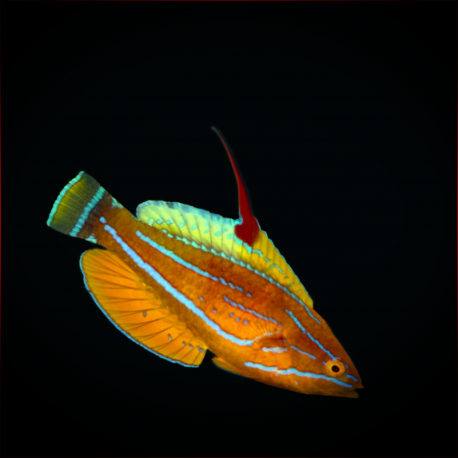More info
Datasheet
| Minimum Tank Size | 200 litres / 52.83 US gallons |
| Maximum Size | 8.0cm / 3.15inches |
| Reef Compatible | Always reef safe |
| Temperament | Docile but might be aggressive towards similar species |
| Temperature | 22.2°C / 71.96°F - 25.6°C / 78.08°F |
| Specific Gravity | 1.020-1.025 |
| Carbonate Hardness | 8-12 |
| pH | 8.1-8.4 |
General Description:
The Yellowfin flasher wrasse, scientifically known as Paracheilinus flavianalis, belongs to the family Labridae. These vibrant Flasher Wrasses are visually striking with colorful patterns and are predominantly found swimming in the water column. They are a peaceful species but can be timid, making them unsuitable tank mates for aggressive fish.
Aquarium Suitability:
Yellowfin flasher wrasses are suitable for aquariums with proper care. It is advised to keep them in pairs or with one male and multiple females. They are known to be shy and docile but might display aggression towards similar species, so caution is recommended.
Demands:
This species requires frequent feeding, especially when first introduced to the aquarium. They should be fed a varied diet that includes small crustaceans like krill and zooplankton such as cyclops. They are sensitive during transportation and acclimatization, needing good hiding spots and patience for acclimation.
Care and Hardiness:
The Yellowfin flasher wrasse demonstrates average hardiness and demands stable water conditions with a pH range of 8.1-8.4, a temperature range of 22.2-25.6°C, a specific gravity of 1.020-1.025, and a carbonate hardness (KH) of 8-12.
Reef Suitability:
These wrasses are known to be reef-safe, making them an excellent choice for reef aquarium setups.
Aquarium Setup:
When setting up an aquarium for Yellowfin flasher wrasses, it is crucial to provide them with hiding places among live rocks. A tank size of at least 200 liters is recommended, with careful consideration when keeping more than one male in tanks under 500 liters.
Behaviour:
Yellowfin flasher wrasses may initially hide when introduced to a new environment. They exhibit captivating social behavior when kept in groups, particularly when there is a male with multiple females present.
Feeding and Diet:
These wrasses should be fed several times a day with a varied diet. Suitable foods include small crustaceans like krill, mysis, and artemia, as well as zooplankton such as cyclops and pods.
Dimorphism:
Male Yellowfin flasher wrasses are typically more visually appealing with longer filaments on their dorsal fin compared to females. They possess the unique ability to change sex from female to male. Hybrids between species in the Paracheilinus genus can make identification challenging.
Habitat and Distribution:
Yellowfin flasher wrasses are primarily found in the Eastern Indian Ocean, specifically in Indonesia and northwestern Australia. Their natural habitat consists of reef environments where they can display their colorful patterns and social behaviors.

